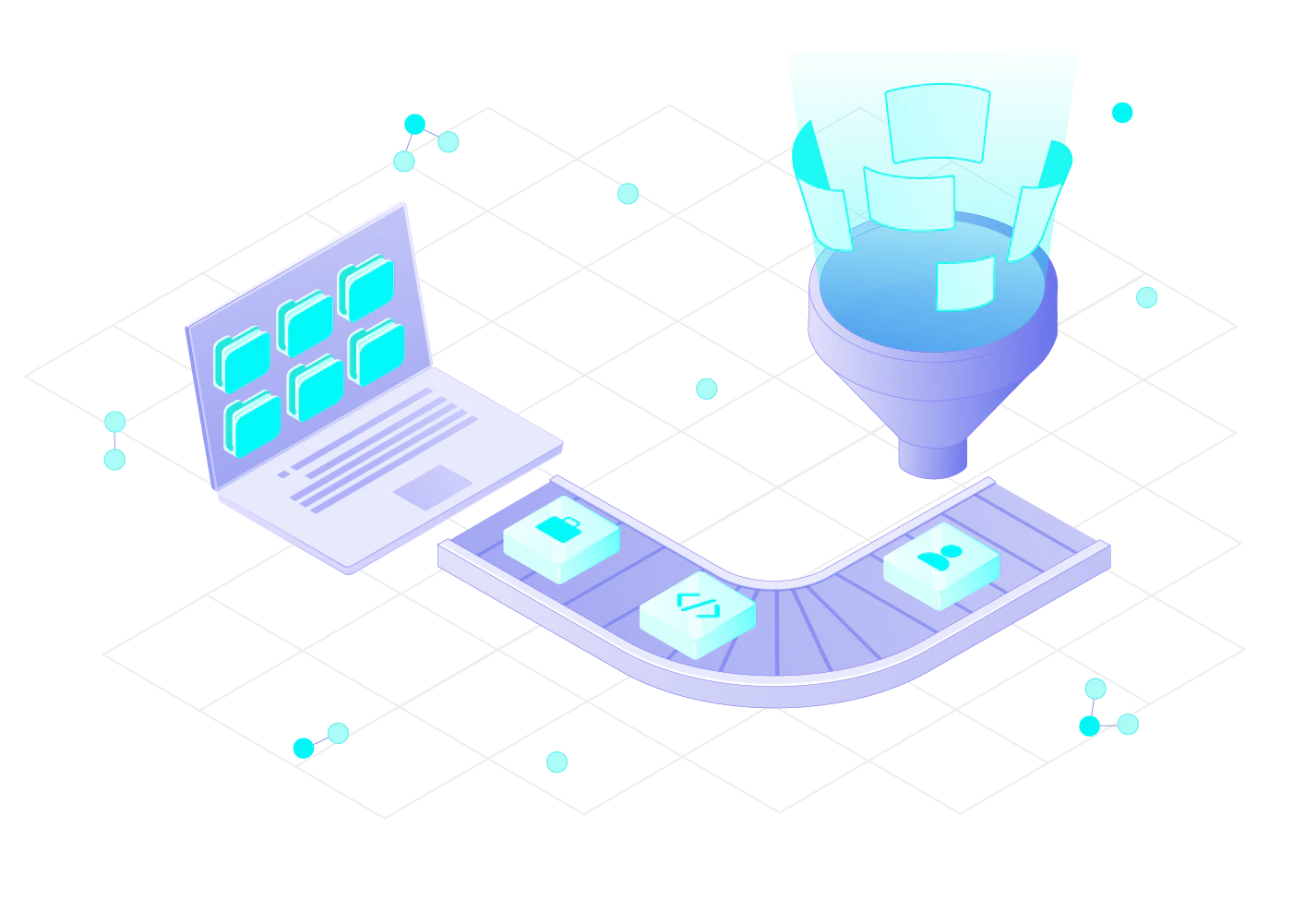Choosing the right data solution for your business can be challenging because there's a wide selection of them, and even the same data can be processed and packaged differently.
I'm here to help you understand when you should consider using database APIs, why this solution is popular, and when it might not be the right choice for your company.
What are database APIs?
An application programming interface (API) is a technology that allows applications to extract and exchange data. Data vendors in the web data industry offer APIs as a method for clients to access specific types of data.
An API may be used to get data to generate insights or power some part of your project on the back end. It can also be integrated into the user-facing tools, such as search engines of a platform you're building.
4 things that tell when you should use a database API
You can decide whether a database API is the right solution for your business by evaluating your budget, product maturity, data team, and data pipeline.
1. Budget limitations
Compared to datasets, APIs are often the cheaper option, popular among companies with smaller budgets for data. It's not only the price of data itself but also the cost of turning it into actionable insights. You may get what you need with a few dataset API queries, while the raw datasets hold little value in their primal form.
Moreover, when using the API, the vendor is responsible for the database storage and maintenance.
2. Product maturity
You may be in the early stages of developing a new project. Naturally, you will likely consider starting with a POC (proof of concept) to build something that doesn't require a lot of resource investment.
Therefore, opting for a dataset during the POC stage might not be the best choice. You will most likely not have the processes in place to combine, handle, and use large volumes of raw data, especially from multiple sources.
Because database API is a tool that can be integrated into the user interface, such as a search field in a dashboard, it already saves you a lot of hassle. What's left is some tailoring of the information according to your product, like eliminating irrelevant fields and visualizing data.
3. Data team
Extracting data from the API using simple commands like "search" or "collect" doesn't require much skill. Most suppliers have proper documentation and customer support.
With the raw dataset – you're on your own. To get something valuable, let alone understand it, you need a professional data analyst, at minimum. If the dataset is huge or if there's more than one, you might need a whole team, adding data engineers or even data scientists.
Of course, the answers you're looking for play the biggest role. Listing your top competitors in the US by revenue is one thing, and finding out whether the demand for your product will grow in the EU next year is another.
4. Data pipeline
Another important question when choosing between a dataset and a database API is whether you already have a data pipeline and work with other data vendors. If you already have your database and your product is based on it, you may benefit more from buying an extensive dataset. If you want to enrich or update specific data records in your database, an API would be a more suitable solution.
How to choose the best database API
Data quality. The most important thing to remember is that a data API is as good as the data you get when using it. Additionally, data freshness and coverage may be important factors to consider if they are relevant to your product.
Data freshness. When it comes to freshness, evaluating if the data connected to the API is not stale is essential. If data is not updated regularly, it won't be suitable for tracking changes or discovering something.
Raw data. If you're considering using a database API that provides scraped data from a specific source relevant to you, it's important to evaluate how raw the data is. When processing and transforming scraped data, the provider makes changes, for example, combining multiple sources, merging, or creating new data fields, and as a result, this data might no longer suit your use case. On the other hand, it might be a benefit. It all depends on business needs.
Provider's reliability. Take into account compliance and data security measures. A database API is a two-way exchange of information. By querying a database, you reveal sensitive business information, so choose your data partners wisely. Check social proof, such as reviews and testimonials of data providers' clients, before committing.
Provider's experience. I recommend finding an experienced data vendor because the web data industry is prone to changes that can be challenging to adjust to without expertise.
3 example use cases of database APIs
To give examples of how companies leverage database APIs, I must provide some context about a solution I am working with.
Our clients are businesses that need fresh B2B data, which often comes from HR technology, sales technology, and investment industries. Using database APIs, they can scrape public company, employee, and job data from public web sources.
Here are some examples of what our APIs are used for.
1. Investment research
An investment company can use a database API to get data on companies they are interested in or to find new opportunities by looking for promising entrepreneurs.
For example, a company data API may get as much valuable data as possible about a company when the investment firm only has its website URL. Investors may also be interested in getting data on that company's talent pool, such as checking previous workplaces of people in leadership positions.
2. Data enrichment
Companies that help businesses find the best-fit talent benefit from database APIs because they get access to extensive datasets containing information about business professionals. Do you need data on as many candidates as possible at all times, or do you need specific data records of candidates who fit particular criteria?
Especially if the data is being refreshed regularly, an API is an excellent tool for sourcing potential candidates that fit specific criteria or for enriching data on candidates they already have in their database.
3. Lead generation
Similarly to the examples mentioned above, sales technology companies use APIs to get data on companies and business professionals that fit their ideal customer profile criteria and may be interested in their products.

Database API limitations
Although the examples above show various ways to use a database API, there are also some possible limitations.
No open-ended queries
One is that querying the database is usually possible only under specific search criteria. So, it is not a convenient option if you want to find insights about open-ended questions, like global trends in particular industries. While this may not be an issue at first, accumulating data will make analysis more complex, especially if you get more datasets.
Scaling ceiling
Another reason might be that you have passed the POC phase, and an API doesn't meet your scaling ambitions. Therefore, you might prefer using large files and consuming data differently.
Many APIs have a limit of requests per IP, so if you have just one, you might need to wait before you can do another operation.
Additionally, you might face a limit of concurrent sessions. In a worst-case scenario, that would disconnect the current user in favor of a new one, resulting in lost or corrupted data.
Dependence on a third-party
Not having to manage a database on your own is a benefit, but it also makes an API user quite dependent on the API's availability. Whether you are the API response's end receiver or your platform's client, service discrepancies might cause issues. Of course, there are other ways to avoid that, such as having a plan B when data needs to be accessed offline.
Similar to what I've discussed earlier, the reliability of the data provider can also become a limitation, mainly due to issues related to prompt communication. For example, if a data provider changes the data structure or even a tiny part of it, like a relevant data field, it might affect your operations.
Even the smallest changes might require considerable preparation on your end, so it is important to get notified early. Consistency is essential when working with web data, and a reliable provider can ensure it. However, using an API still means you have less control in some situations.
Database APIs vs raw datasets
In my experience, the need to create a database API product came from working with companies that want raw web data but don't use large datasets (at least not yet).
Datasets are a good solution for businesses that want to discover what they don't know, and APIs are a great choice for those who already have a good understanding of their exact search criteria and the answers they expect to find. In other words, datasets can answer open-ended questions, and APIs complete requests based on predefined criteria.
However, an API can easily be used to create a subset. Let's say you are using an API to access a CV database. Using an API that allows you to search for records based on specific parameters, you can get only those resumes that fit your criteria.
Usually, APIs are utilized in smaller-scale projects than datasets, while large datasets are often used to analyze macro trends and extract new and unique business insights.
However, it can still work the other way around. Some businesses leverage APIs for large-scale projects and have stuck to this solution for years. Some also combine datasets with APIs—they buy large-scale datasets and use APIs to query them.
Still, it might be hard for others to scale a project because of the API. For example, if an API plan limits the number of requests you can make or the number of data records you can collect, your product might exceed those limits.
Final thoughts
To sum up, businesses often opt for database APIs when they need a tool for the on-demand retrieval of specific data that can be extracted from an existing database. Businesses across various industries leverage database APIs for insights and powering their products.
If you're planning to start using database APIs, define your expectations, research the best ways to use such APIs for getting data, and choose a reliable data provider that will make your experience with this technology a good one.


































